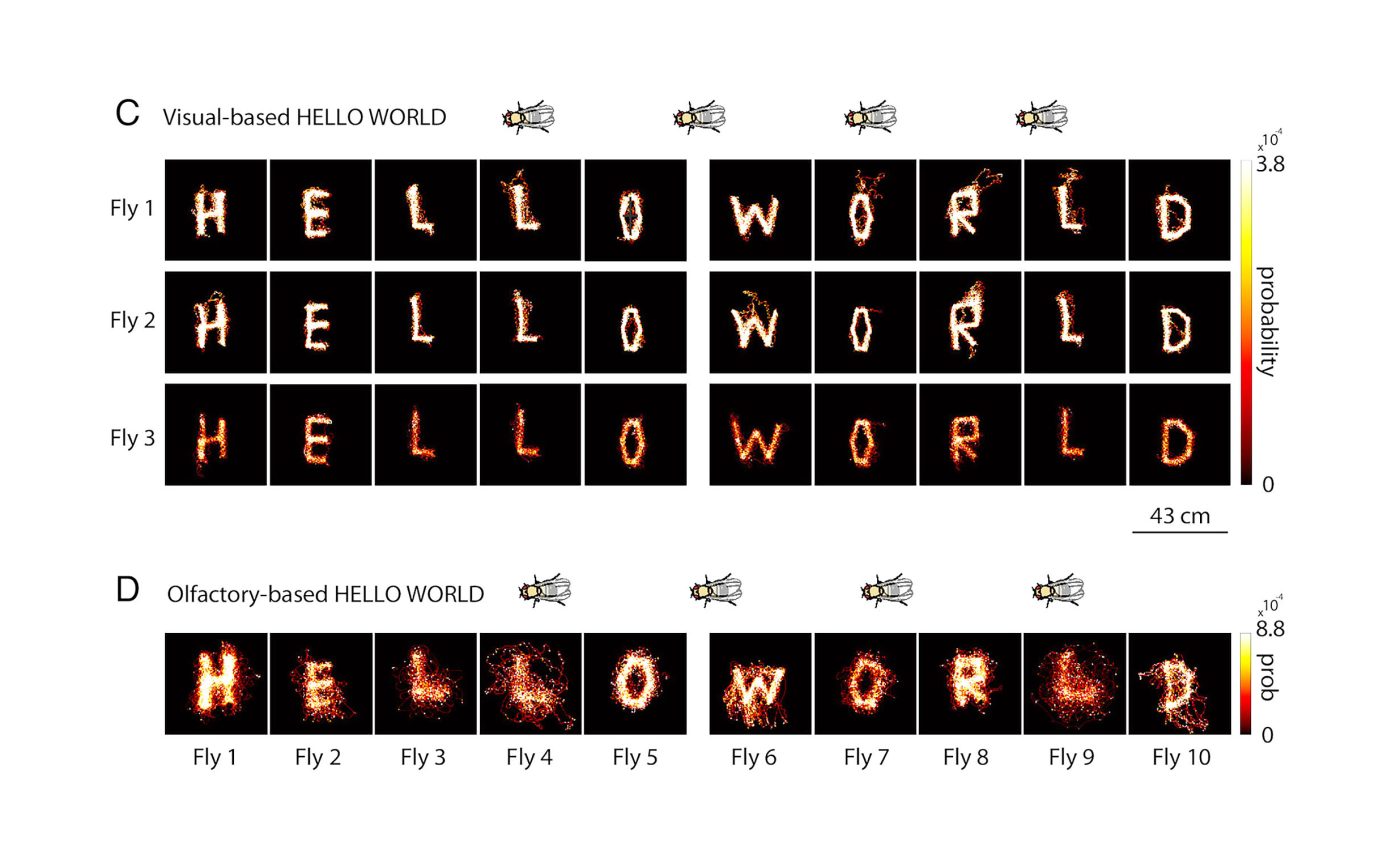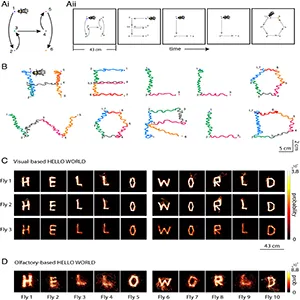
Scientists convert living flies into microrobots, forcing swarms to write "HELLO WORLD"
Tiny robots often struggle with batteries, sensors, and navigation, yet a common fruit fly already packs all three in a two and a half millimeter body. Researchers at Harvard’s Rowland Institute have now learned to steer those insects as if they were remote controlled microrobots, trading silicon for living tissue.
The team reports that it can point Drosophila melanogaster along preset routes, flip its heading on command, and even choreograph a swarm that traces the phrase “HELLO WORLD” across a floor.
Lead author Kenichi Iwasaki of the Rowland Institute explained that the work shows how biology can solve problems that stump microengineering.
Turning live flies into microrobots
The first trick relied on the fly’s optomotor response, an ancient reflex that keeps moving patterns stable on the retina.
By projecting a rotating blue and black pinwheel, the scientists nudged the insect to veer right or left, achieving 94 percent waypoint accuracy in a five inch corridor.
Visual cues were only half the story. The group also used optogenetics to plant light sensitive channels in each antenna, letting red or blue flashes mimic odor plumes and pull the fly toward a target with 95 percent fidelity after a brief neural tune up.
Building a miniature autopilot
To keep left and right commands separate, one antenna was coated with blue blocking dye and its twin with red blocking dye, creating a simple “two bit” control channel.
Because the fly supplied its own muscles and metabolism, the external hardware shrank to an overhead projector, a camera, and a computer smaller than a lunchbox.
When tested side by side, light steered flies covered the thirteen inch track four times faster than untreated controls and wandered half as far off course, performance that held steady for hours without food rewards.
That durability hints that the reflexes sit below the insect’s motivational circuitry, so guidance does not need constant recalibration.
From scribbles to “HELLO WORLD”
After mapping simple lines, the researchers strung thirty one checkpoints into the outline of ten letters, guiding a single fly to walk each stroke until the phrase appeared on screen.
The insect finished the “writing” in just under seventeen minutes, confirming that the closed loop system can handle complex sequences.
In parallel trials three separate flies played the role of independent pens, each assigned a subset of strokes, and still reproduced the message legibly.
The multi-pen demonstration shows that guidance commands can be broadcast in parallel without mixing up which insect receives which cue.

Microrobots haul loads and walk mazes
Size does not equal weakness. A fly weighing a single milligram hauled an extra milligram of brass, roughly 0.000035 ounces, back and forth between two points more than six hundred times before tiring.
When the arena was replaced with a seventeen inch square maze lined by dead end branches, the pinwheel guidance still kept insects on the main loop for hundreds of laps.
Those trials show that the method works even when walls block direct sightlines and cast confusing shadows.
Borrowing nature for microrobotics
Conventional microrobots often stall once they leave the lab, because dust, humidity, and radio interference swamp their fragile circuits.
A living fly reared for pennies in a jar brings built in power, stereo smell, and a flight computer honed by evolution, delivering fault tolerance that engineers currently pay for in weight and expense.
Swarms of such “biobots” could sniff hazardous leaks, map collapsed buildings, or pollinate rows of strawberries without the carbon footprint or price tag of disposable electronics.
Soft robotics specialists say biological carriers could also ferry sensors deep into rubble that wheeled machines cannot enter.
“Fruit flies have evolved for millions of years to handle tight spaces and unpredictable environments,” said Sasha Rayshubskiy, Rowland Fellow at Harvard University.
His group believes that modest on board gadgets will be enough to steer the insects outdoors once proof of concept backpacks now tested on cockroaches move below the one milligram threshold.
From lab to field tests
Solar powered “circuit saddles” only four hundredths of an ounce have already helped cyborg beetles right themselves after falls, suggesting similar packs could drive flies for days without human input.
A recent study showed that a swarm of such cyborgs can navigate dunes without bunching up, thanks to simple neighbor to neighbor rules.
Transplanting that algorithm onto fruit flies could let hundreds sweep a greenhouse for pests, each insect sharing only local information yet covering acres faster than a single drone.
Because the guidance signals piggyback on reflexes rather than override them, the team predicts that the insects will still sleep, eat, and mate on schedule, reducing welfare concerns.
Hurdles remain for living microrobots
Engineers still need to miniaturize guidance hardware to under one milligram, the payload limit seen in weight tests.
They must also ensure that artificial cues do not block essential behaviors such as feeding, which would shorten any field deployment.
Ethicists will ask how much autonomy a sentient agent should sacrifice for human benefit.
The Harvard group argues that the flies already use the same reflexes in nature, so the intervention resembles turning up the volume rather than rewriting the score.
A glimpse at future swarms
Because each insect costs pennies to rear and requires minutes to train, fleets numbering in the thousands are plausible.
Machine vision algorithms could direct those swarms to converge on odor plumes, forming a living, distributed sensor that highlights pollutant hotspots in real time.
Meanwhile laboratory neuroscientists gain a bonus tool, a way to hold a moving fly at any coordinate, then record how specific brain cells behave when the animal chooses, or refuses, to follow orders.
That feedback loop could clarify decision making at a resolution unseen in larger animals.
The study is published in Proceedings of the National Academy of Sciences.
—–
Like what you read? Subscribe to our newsletter for engaging articles, exclusive content, and the latest updates.
Check us out on EarthSnap, a free app brought to you by Eric Ralls and Earth.com.
—–













